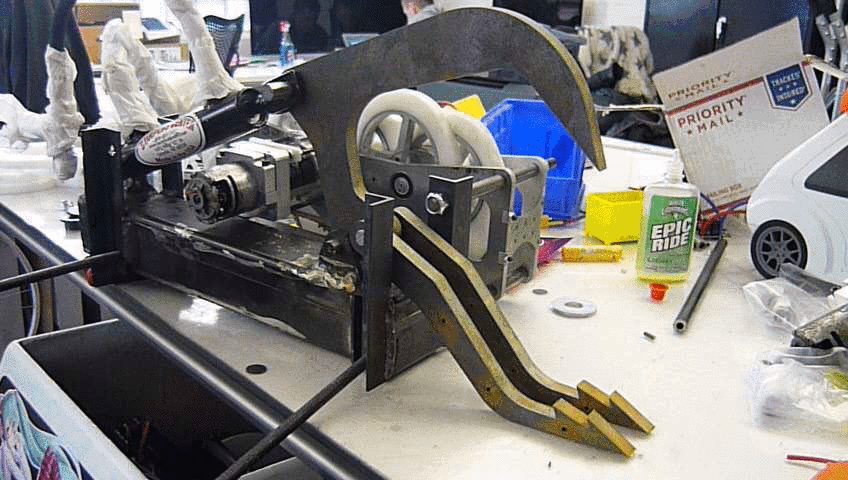Dane.Kouttron
[2.27.15] Combat Robot: Fission-Product
| What? |
Everchanging CAD |
Frame Welding | Shuffles and Cams | Motorama | Conclusion | Image Directory |
| OPTIMIZE FOR PINCH
POINTS Fission product was born as an iterative Solidworks design. Shown right is the robot in working CAD form, with both shuffles actuating and jaw chomping. Note the 'chomp' action is on a linkage, allowing combined lift-chomp from one actuator. The drive propulsion is based off of the equalszero DEWUT, motor assembly, highly reccomended. The following page documents design decisions, hardware fabrication, testing and modifications to the robot as well as feedback from its operation at the 2015 motorama combat robots event. If you're interested in shuffle propulsion, stay tuned. |
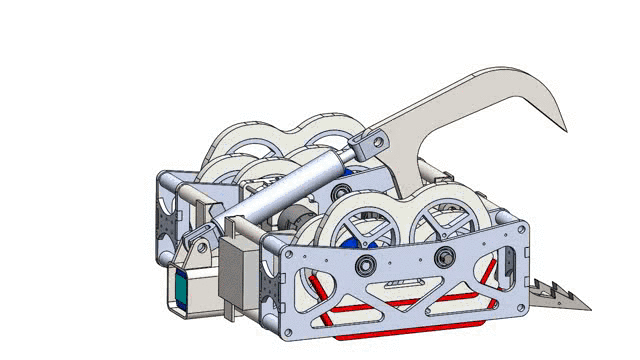 |
| Whats
in a name |
|
| Whats a fission
product? Fission Products
are the fragments left over from fission reactions, some short lived
'out there' elements that rapidly decay and a distributuon of more
common longer half-life elements. This robot is a strange one, with a
fast moving shuffling drivetrain and non traditional hydraulics in a 30
lb weight class. Image from [link] |
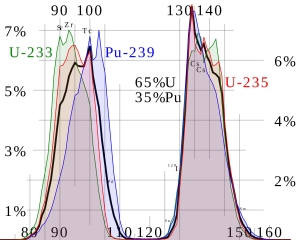 |
| CAD:
Brought to you by snow-days and mount Albany |
||
| The robot design phase occured
during the 2015 snow-blizzard apocylapse. Roads were blocked, MIT was
closed, trains were stuck, but Solidworks and team bercu-tron powered
on through some cold evenings. rendering of the complete bot is shown (right). The heart of the bot was a surpluscenter hydraulic gearpump and piston. |
||
| Anote
about dual-wielding CAD This has been a recurring theme in recent projects; its fairly cumbersome to 'parallel' work on a CAD model, so there's a lot of meetup and CAD-jam sessions. Fortunatley, this does bring about a bunch of interesting ideas as to how to design around issues, and optimize loading. These sessions generally ran into the late evenings, resulting in the next-day's meetup to start with 'what the heck were we thinking at 3am', and a bit of iterative re-design. |
||
| Overview A top view shot of the robot shows the intended hardware placement. Note that the hydraulic gearpump was modeled as a box, as it was fairly slow to arrive from surpluscenter. The shuffle assemblies are rotated mirrors of eachother, as this allowed the robot to have a smaller width-wise footprint. |
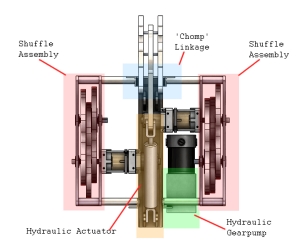 |
|
| Hydraulic
Hardware and Hydraulic loop haisha The pump in question is a parker gear motor pump, available at surpluscenter [link], information about the pump can be found in the parker manual [link]. Interestingly this pump is bi-directional, unlike most equivalent gear pumps, and has a power transfer of ~10hp in a relativley small amount of space. There's even a nifty drawing of the part now [link] |
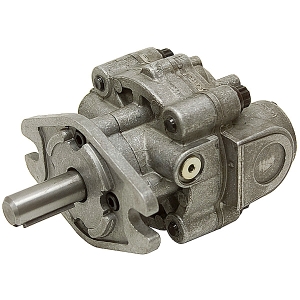 |
|
| Shuffle
feet and shuffle assemblies The shuffle assemblies consist of 3 major parts, a CAM, a shuffle housing and the traction material. The design avoided bearings by using a slippery material for the shuffle itself. The delrin plastic is low friction but relativley strong, creating a bearing surface on the machined CAMs. Each cam rotates inside the shuffle. The traction material mates with screws in tapped holes. The traction material (red) has an internal fiber layer as well as a high surface area traction material. The mounting screws deform the traction material and connect the fiber reinforced layer. |
||
| Electronics
and battery assembly The heart of the electronics for this build were two ragebridges, one for propulsion and the other operating in a dual-mode for current feed into the weapon actuator. |
| Shuffle Layout | Image / Media |
| The shuffle mechanism in moving, see-through form. Note the cam design contains 3 mounting points for keyways, allowing the same CAM to be used on all shuffle legs |
| Shuffle Test 1 | Image / Media |
| One
of the early tests of the shuffle propulsion system. Just needed some lubricaltion, that proceeded to spray everywhere. |
 |
| Crushing the closest thing we could lay our hands on | |
| We
crushed a free post office cardboard box with ease. Design Verification Testing Complete SHIP IT. |
| Motorama 2015 | ||
| ITS
ROBOT FIGHTING TIME, Kinda. Myself, Charles Guan, Becca, Bercu, Fred, Berkowitz and Cynthia headed west to the mighty state of Pennsylvania. We proceeded to get to the event, set down our things, plug in our tools... and fall asleep on Rob Maseks Brand new Trailer after road-tripping for ~8 hours through the night. |
||
| Motorama
is a special place There's amish folk making hotdog-pretzel buttery deliciousness, there's lifted jeeps and threre's kids watching robots on a tv in front of a robot arena. Its a great time highly reccomended. The robot-fighting folks are the odd-ducks to the native pennsylvanians and its always nice to see a crowd peering in from the motorcross events at the robot contraptions. |
||
| Pre-fight
Glamour shots Special thanks to Dale's portable photobooth. We may have leaked a bit of hydraulic fluid @___@ |
||
| The
beast awakens Here we are at our table, unpacking and getting everything ready for a once-over. Such a pretty bot. |
||
| There
were some minor adjustments to be made. We ended up rebuilding the shuffle mechanism a few times to try and get any bound sections to 'clear'. I ran to a moped-cycle-atv table and found some chain-lube for $5, this became our new problem-solver / mess creator. Thanks moped folks! |
||
| Taking
appart the shuffles Disassembling the shuffles was a pain. We quickly came to the conclusion that the shuffles should be modular and removeable to make it easier to work on. The assemblies do require a decent-tolerance mate between the cam's and the shuffles. Unfortunatley all shuffles and cams arent completley identical. There was some back and forth play to get the shuffle assemblies to play well together, it was greasy. |
||
| Shuffles
coming back together. Small lasercut petg 'washers' are used to keep the opposing shuffles apart from each other. |
||
| More teardown and
rebuilding Allignment and reconfiguring continued. At this point a 'modular' or removeable shuffle drivetrain was brought up. Most noteably, not requiring to manipulate the whole bot every time we wanted to remove something would have been excellent. The structural allignment members of the shuffles were part of the frame. Removing this constraint would be a step forwards for the next iteration. |
||
| Shuffle-shields With our non-existant extra mass leftover, thin polycarbonate was haistly added to shield the shuffle-drive. |
||
| Safety
First A Xo armors the Bercu with old-timey safety glasses. Do you need goggles with side armor? you're in luck! mcmaster-carr pn xyxyxy. |
||
| Holes and zipties ahoy | ||
| What
kind of polycarbonate did we use? VIRTUALLY INDESTRUCTABLE BRAND POLYCARB |
||
| Into
the arena We faced a 'long screw' bot. |
(There's
other photos in the photo gallery)
Concluding
Remarks:- Do it. You can build a competitive robot in a week
- Call in for reinforcements! If you have comrades with free hands, enlist them! Victory is at hand!
Hydraulics worked, they had quirks and air pockets are your enemy, but it was a great proof of concept. Ragebridges held up under the fairly high power loading of the 'sticky drivetrain'. The surplus center hydraulics
What could use improvement:
The shuffle mechanism relied on some close tolerances and non-rolling-element bearing surfaces. The tolerance stackup did not work in our favor and the mechanism was subject to jamming. After talking to xyxyxyx about shuffling at motorama 2015, we learned that driving the shuffle-mechanisms from both sides, in a synchronized fashion, prevents a bit of the bind-up that we kept running into. Finally running more than 3 shuffle-phases helps reduce ripple bounce when driving.
Special thanks to Rob Reeve and A. Birkel
If you have questions or comments, ask below or send over an email.
| Comments: |
|
HTML Comment Box
is loading comments...
|
(be
careful, im not responsible for your welding tan or hydraulic sheen)
Dane.Kouttron
Rensselaer Polytechnic Institute
Electrical & Electrical Power
631.978.1650

